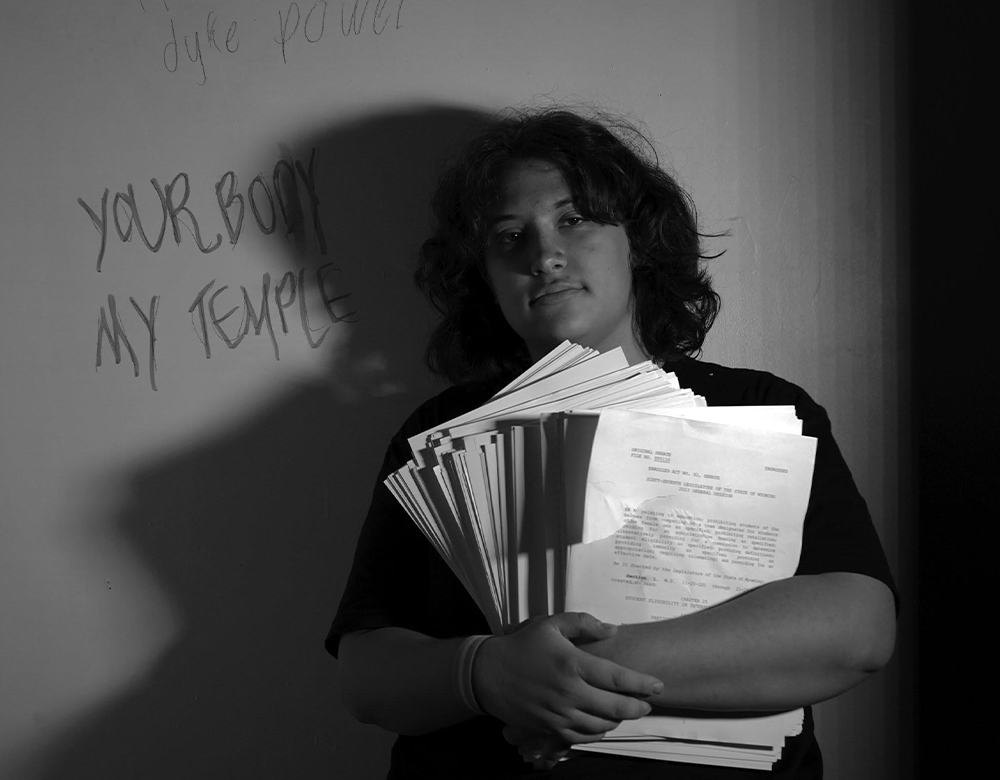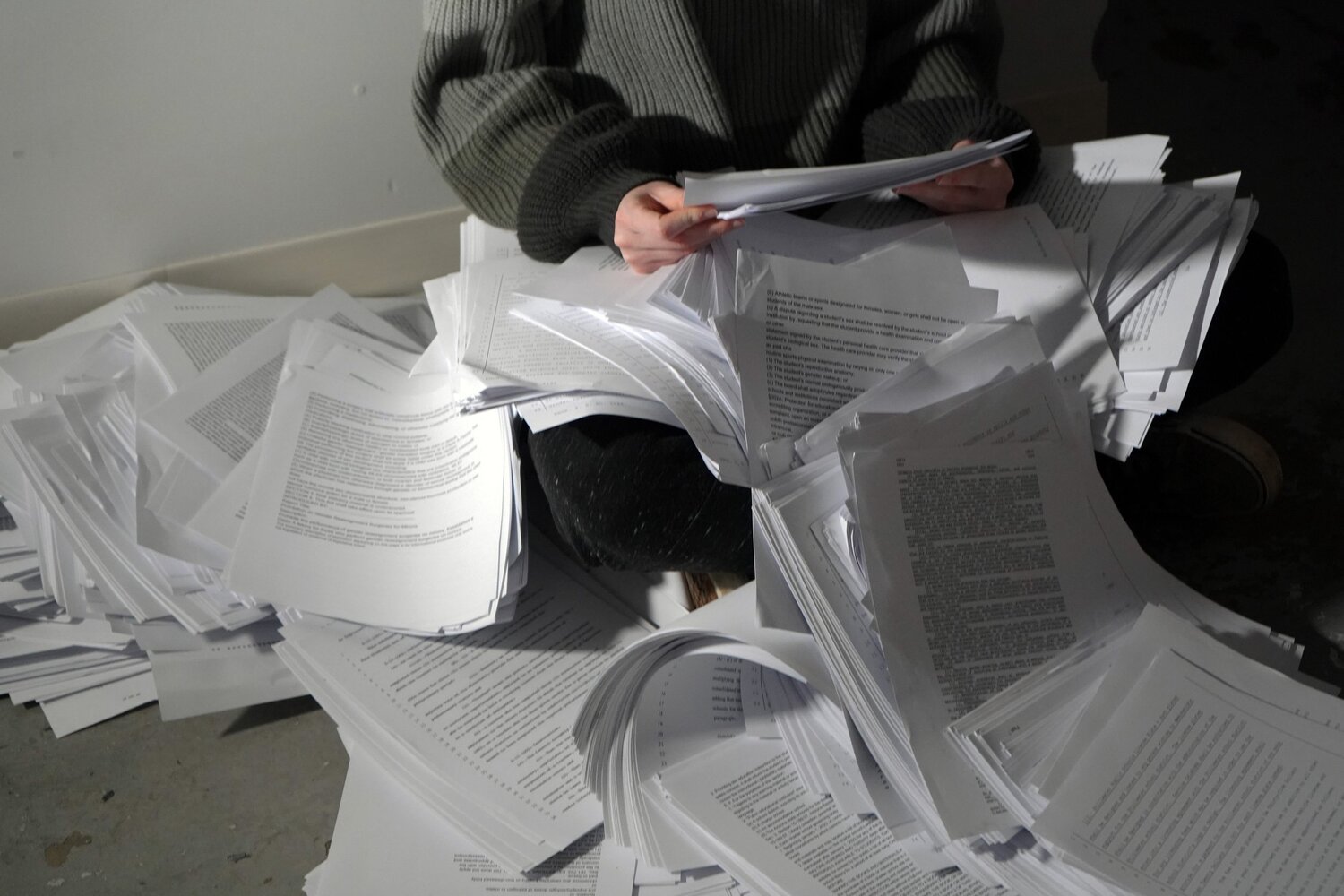Maggie Letvin
Year of birth: 2002
Where do you live: Maryland
Your education: I have three bachelors degrees in Studio Art, Art History, and Immersive Media Design from the University of Maryland
Describe your art in three words: Layering, Experimental, Punk
Your discipline: Printmaking, performance, installation, multimedia/other
Website | Instagram

Your work engages with discomfort and evokes intense reactions from the viewer. How do you decide what emotions or responses you want to provoke through your art?
I think when I was first starting to explore discomfort, I wanted to get a reaction and freak people out by being provocative. As I’ve grown as an artist, I’ve learned that it’s all about balance and embracing the unexpected. I don’t necessarily have a prescriptive reaction that I want people to have, it’s more about starting from a place of my own discomfort and getting it out through my work. Some of that discomfort is transferred to my viewer in my work, and it can range from shocking to subtle.
out through my work. Some of that discomfort is transferred to my viewer in my work, and it can range from shocking to subtle.
Can you describe a specific piece where you felt you successfully transferred a sense of discomfort to the observer? What was the process behind it?
I created a collaborative work called “60 Seconds and Counting” that was installed in the women’s restroom and confronted viewers with the average time it takes in the United States for a woman to be assaulted. My intention with placing the work in the women’s restroom wasn’t to make some kind of association between the bathroom and assault, but rather to probe the audience to question the gender binary and their role in the patriarchy. There were several men that treated the women’s restroom like a danger zone, even when they were invited in. Those were the people that I wanted to place in an environment of discomfort- the goal being that uncomfortable feeling is something that they can take with them and something that can actually affect them and have them reflect on change.
 Maggie Letvin | Cross Contamination | 2022
Maggie Letvin | Cross Contamination | 2022
Your work often combines printmaking with performance. How do you integrate these mediums to create a multisensory experience for the viewer?
Creating prints is always a performance, even if no one is watching. I will attack my prints, spit on them, step on them, scratch them, rub cigarettes on them, be kind with them, be rough with them, etc. In a similar way, my performances are often inspired by or closely connected to my print work. For example in my performance “Hard to Swallow” I consume a pound of paper pulp- that same pulp was used to make the paper that my more print-based works in the ant-transgender project. One hundred percent anti-trans legislation in both the pages and in my performance.
You explore themes around gender identity in your art. How has your understanding of your own identity influenced the direction of your artistic practice?
Like my work, it can get complicated. I had a very intimate relationship with the 3,304 page document of anti-transgender legislation. There are equally as many moments that are beautiful as those that are painful. When you feel nostalgia, growth, and loss in your body at the same time, 50 pounds of legislation that is against you produces intense reactions and interesting ideas.
 Maggie Letvin | Cross Contamination | 2022
Maggie Letvin | Cross Contamination | 2022
Many of your works challenge societal systems and structures. What message do you hope your audience takes away from confronting these uncomfortable themes?
Be yourself. You are not alone. Questioning the system is challenging, but so deeply important. For those that get it, I hope they join me. For those that don’t, I hope my work makes them think.
How do you approach experimentation in your practice, especially when it comes to exploring uncomfortability through different materials and media?
I love experimentation so much. I’ve had a lot go off course but have learned so much for embracing the results and pivoting- rotting insects for example, produce an intense smell that is quite repulsive; that sensorial result was not something that I planned for in my prints that were exploring themes of grotesque and belonging, but it added to the whole experience. I love asking questions and trying things that might fail. What happens when I try to grow mold on paper? Can I print with pig’s blood? Can I grow wildflowers from my feces? No, just maggots? Okay, what happens if I run them through the press? So much of the discomfort in my work comes from the experimentation with strange techniques and unconventional materials.
 Maggie Letvin | Untitled | 2023
Maggie Letvin | Untitled | 2023
What role does vulnerability play in your creative process? How do you balance personal discomfort with the need to challenge your audience?
As I’ve grown as an artist, I’ve learned that not everything has to be in your face. I love taking a direct approach, but vulnerability and subtly can be tools that are equally as powerful. Intimacy is another one of those tools that challenges the audience; so combining the approach of having deeply personal poetry that has an ephemerality with this intense theme of transphobia that you have to look closer to see, I think that is still uncomfortable and challenging. My work does not have to make everyone feel the same way, it just has to make the audience feel something.

Leave a Reply